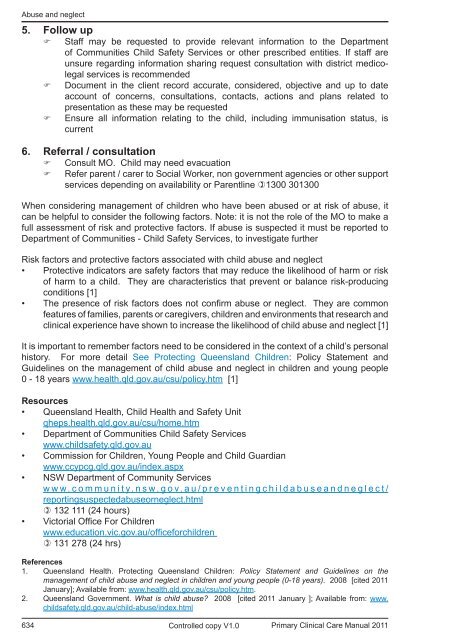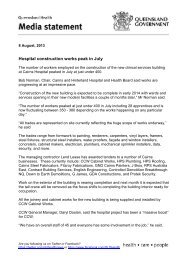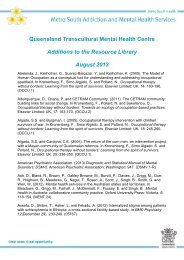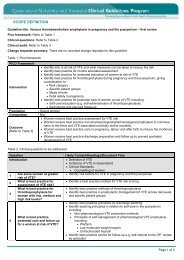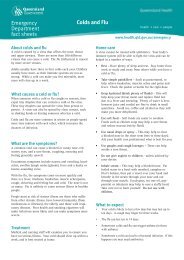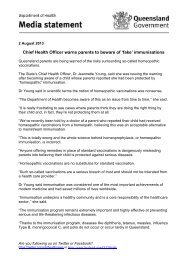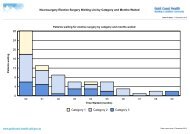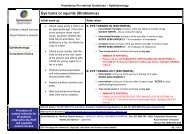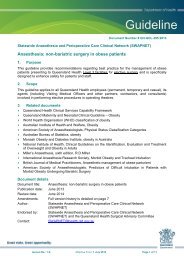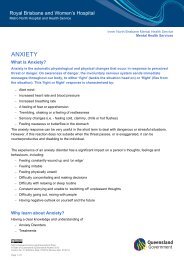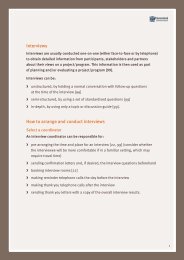Paediatrics - Queensland Health - Queensland Government
Paediatrics - Queensland Health - Queensland Government
Paediatrics - Queensland Health - Queensland Government
Create successful ePaper yourself
Turn your PDF publications into a flip-book with our unique Google optimized e-Paper software.
Abuse and neglect<br />
5. Follow up<br />
Staff may be requested to provide relevant information to the Department<br />
of Communities Child Safety Services or other prescribed entities. If staff are<br />
unsure regarding information sharing request consultation with district medicolegal<br />
services is recommended<br />
Document in the client record accurate, considered, objective and up to date<br />
account of concerns, consultations, contacts, actions and plans related to<br />
presentation as these may be requested<br />
Ensure all information relating to the child, including immunisation status, is<br />
current<br />
6. Referral / consultation<br />
Consult MO. Child may need evacuation<br />
Refer parent / carer to Social Worker, non government agencies or other support<br />
services depending on availability or Parentline 1300 301300<br />
When considering management of children who have been abused or at risk of abuse, it<br />
can be helpful to consider the following factors. Note: it is not the role of the MO to make a<br />
full assessment of risk and protective factors. If abuse is suspected it must be reported to<br />
Department of Communities - Child Safety Services, to investigate further<br />
Risk factors and protective factors associated with child abuse and neglect<br />
• Protective indicators are safety factors that may reduce the likelihood of harm or risk<br />
of harm to a child. They are characteristics that prevent or balance risk-producing<br />
conditions [1]<br />
• The presence of risk factors does not confirm abuse or neglect. They are common<br />
features of families, parents or caregivers, children and environments that research and<br />
clinical experience have shown to increase the likelihood of child abuse and neglect [1]<br />
It is important to remember factors need to be considered in the context of a child’s personal<br />
history. For more detail See Protecting <strong>Queensland</strong> Children: Policy Statement and<br />
Guidelines on the management of child abuse and neglect in children and young people<br />
0 - 18 years www.health.qld.gov.au/csu/policy.htm [1]<br />
Resources<br />
• <strong>Queensland</strong> <strong>Health</strong>, Child <strong>Health</strong> and Safety Unit<br />
qheps.health.qld.gov.au/csu/home.htm<br />
• Department of Communities Child Safety Services<br />
www.childsafety.qld.gov.au<br />
• Commission for Children, Young People and Child Guardian<br />
www.ccypcg.qld.gov.au/index.aspx<br />
• NSW Department of Community Services<br />
www.community.nsw.gov.au/preventingchildabuseandneglect/<br />
reportingsuspectedabuseorneglect.html<br />
132 111 (24 hours)<br />
• Victorial Office For Children<br />
www.education.vic.gov.au/officeforchildren<br />
131 278 (24 hrs)<br />
References<br />
1. <strong>Queensland</strong> <strong>Health</strong>. Protecting <strong>Queensland</strong> Children: Policy Statement and Guidelines on the<br />
management of child abuse and neglect in children and young people (0-18 years). 2008 [cited 2011<br />
January]; Available from: www.health.qld.gov.au/csu/policy.htm.<br />
2. <strong>Queensland</strong> <strong>Government</strong>. What is child abuse? 2008 [cited 2011 January ]; Available from: www.<br />
childsafety.qld.gov.au/child-abuse/index.html<br />
634<br />
Controlled copy V1.0<br />
Primary Clinical Care Manual 2011


